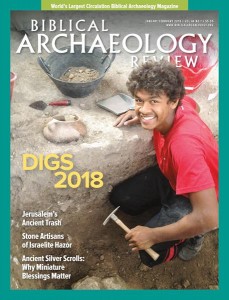Broken Pots, Reconstructed Identities
Sidebar to: Jerusalem and the Holy Land(fill)
Huge quantities of pottery fragments were found in the ancient Jerusalem landfill—about 11,000 indicative sherds (fragments of rims, necks, handles, bases, and even decorated body sherds that allow us to recognize the shape, function, and occasionally the origin of the vessels) were analyzed. Studying this pottery not only helps in determining the time in which the landfill was operational, but also allows us to reconstruct the household activities for which the vessels were used before they were thrown to the garbage, and even to understand how the landfill was formed.
We realized that most of our pottery types belong to a single, short period between the end of the first century B.C.E. and 70 C.E., just before the Romans destroyed the city. Very few pottery types dating from the late second to early first centuries B.C.E. were discovered (less than 1 percent of our collection).
Already a library member? Log in here.
Institution user? Log in with your IP address.

